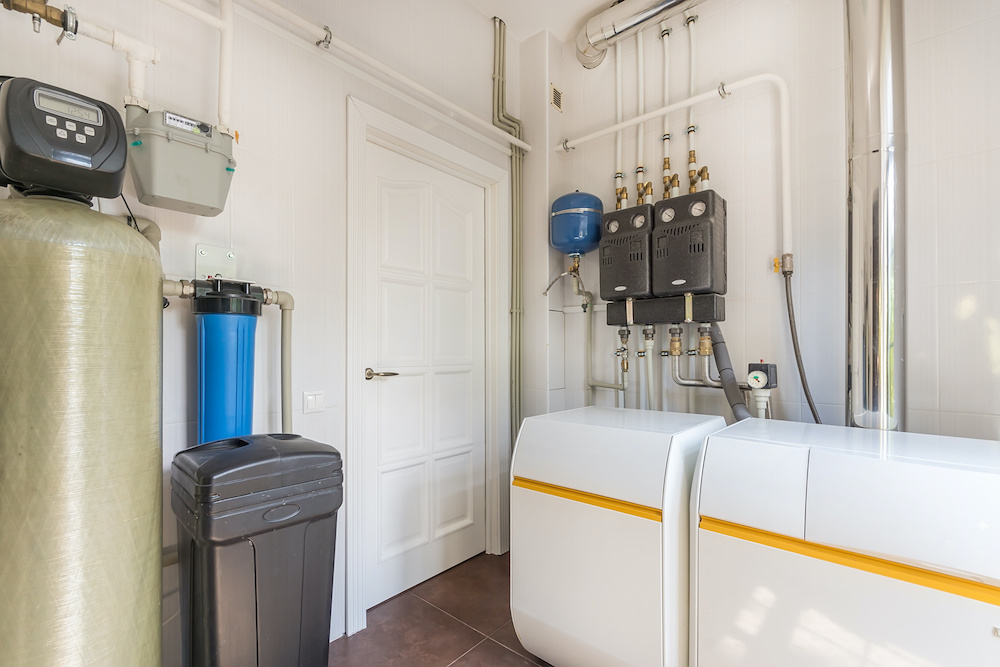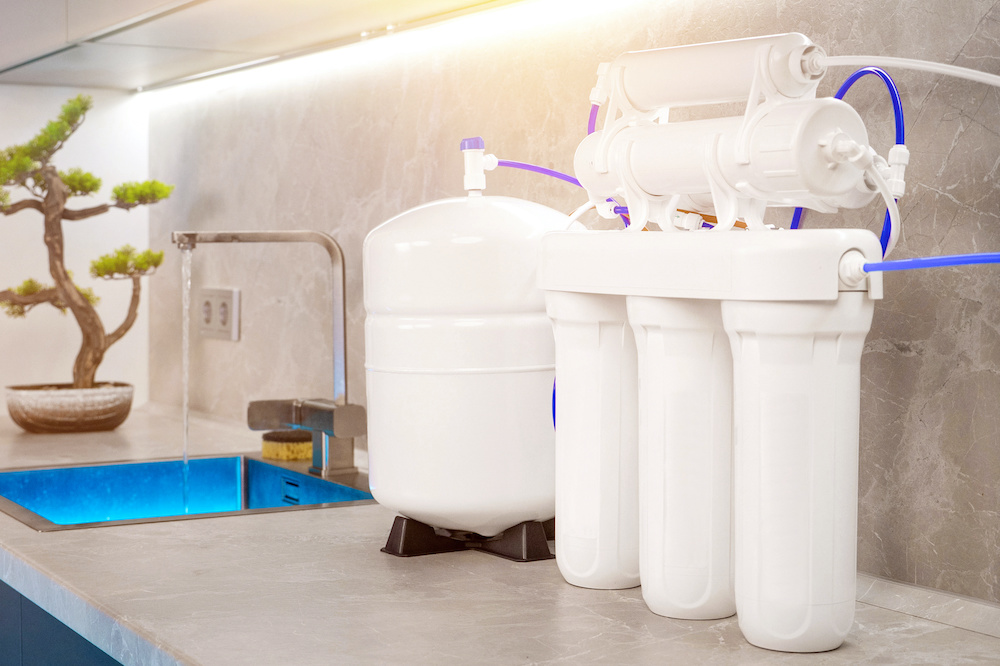Water treatment often goes unnoticed until you taste something off in your water.
Does it taste like metal or chemical? Is it discolored?
All these could have been prevented by installing a water treatment system.
Reverse osmosis (RO) systems and water softeners are two of the most common water treatment systems in the US.
Essentially, an RO system filters water by pressuring it through a semi permeable membrane that removes up to 99% of contaminants.
On the other hand, water softeners remove corrosion-causing hard minerals from the source water. However, it doesn’t filter out other contaminants.
Let’s discuss further the reverse osmosis vs water softener debate and see which better fits your needs.
Reverse Osmosis vs Water Softener
A point-of-use reverse osmosis system can work together with a whole-house water softener system to take care of most of your household water concerns.
Point-of-use systems only treat water in a particular location, such as a sink, while whole-house systems work for your entire house.
This means that you could install both types of systems, since they each serve a different purpose.
To walk you through the two systems, let’s discuss their differences, benefits, and disadvantages in more detail.
What Is Reverse Osmosis?
To fully understand reverse osmosis technology, let’s examine how osmosis works first.
In essence, osmosis happens when a solution with a lower molecular concentration moves toward a solution with a higher molecular concentration.
For example, let’s say we have two containers separated by a semi-permeable membrane: one full of freshwater and the other full of saltwater.
The freshwater will inevitably get pulled toward the saltwater since the latter has added sodium ions.
As their name implies, RO systems work like this, albeit in reverse.
Using pressure, the process is reversed, causing the water from the higher concentration side to be forced through the membrane, leaving behind up to 99% of total dissolved solids such as minerals, salt ions, organics, and bacteria.
Benefits of Reverse Osmosis Systems
Here are some of the advantages of using reverse osmosis systems:
- Gives You Up to 99% Water Filtration
RO systems give one of the highest levels of water filtration.
It means you can rest assured that you’re safe from contaminants in your drinking water.
- Removes Minerals That Cause Hard Water
Like a water softener, RO systems can also remove hard minerals such as calcium and magnesium.
However, note that a point-of-use RO system can only lessen hard water damage on the outside (water stains).
It can’t remove scale buildup on the inside as with whole-house water softeners.
- Can Make Your Water Taste Better
Installing an RO system can result in better-tasting water.
Certain contaminants can give your water an unpleasant taste, no matter how subtle it may be. Not only that, but it can also affect how your food taste.
Disadvantages of Reverse Osmosis Systems
As it isn’t a perfect system, here are some of the drawbacks of using RO:
- Wastes Water
Some RO systems can take up to five gallons of source water just to give you one gallon of filtered water.
he waste ratio should be something you check when purchasing a Reverse Osmosis system to ensure you’re getting. There are a range of different ratios, from 5:1 down to 1:1 (waste to clean water).
- Also Filters Out Healthy Minerals
Since an RO system uses an ultrafine semi-permeable membrane, it also filters out beneficial minerals commonly found in domestic water sources, such as fluoride, potassium, magnesium, calcium, nitrate, and phosphorous.
However, you can get add-ons to your RO that add healthy minerals back into your filtered water.

Technical Considerations for Reverse Osmosis Systems
When using RO, you need to consider the following first:
- Initial Cost
Whole-house RO systems can cost $700 to $8000, depending on your house’s size.
Meanwhile, point-of-use RO systems can cost between $150 and $2000, depending on the brand and model.
Both quotations also depend on the installation method, which we’ll discuss later.
Also, note that there are potential quality differences between an RO system bought online compared to one professionally recommended by a reputable dealership.
- Maintenance Cost
You can expect to spend around $50 to $200 a year for system maintenance costs, including membrane change, repairs, and checkups.
- Flow-Rate
RO systems can give you around 10 to 100 gallons of filtered water daily, depending on the brand and model.
- Water Consumption
As noted, RO systems may need one to five gallons of source water to give you a gallon of filtered water.
What Are Water Softeners?
Water softeners remove magnesium and calcium ions from your water source using sodium ions.
This process effectively turns hard water (mineral-rich water that causes staining and clogging) into soft water.
But how do they do that? Typically, water softeners have two main parts: the resin tank and the brine tank.
The resin tank contains resin beads coated with positively-charged sodium ions that attract the negatively charged mineral ions.
The chemical process results in the exchange of the minerals ions with the sodium ions.
Modern water softeners can automatically “regenerate” their resins’ positive charge by soaking them again with the brine solution from the brine tank.
This regeneration process also washes away the remaining calcium and magnesium ions that have stuck.
Benefits of Water Softeners
The top reasons you should consider using water softeners are:
- Prevent Hard Water
Hard water can ruin kitchen and metalware due to their naturally-corrosive mineral composition.
Also, mineral-rich water can make it hard for dishwashing soap to rinse off, making it less effective.
Hard water can also clog pipes and water using appliances with mineral deposits in the long term, causing expensive appliance or plumbing repairs.
Fortunately, you can remedy this by installing a whole-house water softener.
- More Suitable for Hygiene Purposes
As mentioned, hard water can make it difficult for soap to rinse off properly, thanks to the presence of calcium and magnesium.
This also results in the formation of “soap scum” that can get stuck to shower walls.
Hard minerals can also dry your skin and hair since they can strip them of moisture with continued use.
Disadvantages of Water Softeners
Here are some drawbacks to using water softeners:
- May Harm the Environment
Salt-based water softeners may be an environmental threat since they can potentially salinate freshwater systems.
Also, some community water treatment facilities are not designed to handle the chloride by-products from the brine tank’s salt-based solutions.
- Do Not Filter Water
The biggest difference between an RO system and a water softener is that the latter doesn’t filter the water.
It means that any non-calcium or magnesium contaminants will remain.
Although most tap water in the US meets EPA standards for “safe” drinking when leaving the treatment facility, the EPA uses a standard that considers the cost of contaminant removal vs the actual safe drinking level.
There are also a number of ways your water can become contaminated after leaving the facility, when it travels through miles of pipes, and the pipes in your home, to get to your faucet.
Technical Considerations for Water Softeners
Before installing a water softener, here are some considerations to keep in mind:
- Initial Cost
Typically, water softener systems cost $500 to $6000, depending on the installation process and model.
- Maintenance Cost
You can expect to spend around $150 to $2000 a year to maintain a water softener. This price range includes salt and resin replacement prices.
- Flow-Rate
Generally, you can get up to five gallons per minute with a standard whole-house water softener system.
This number is considerably greater than the RO system’s flow rate.
- Water Consumption
Unlike RO systems, water softeners don’t waste water when treating the source water.
However, it needs a considerable amount when recharging the resins with the brine solution.
Typically, water softeners need around 15 to 25 gallons of water to regenerate, but larger models may consume up to 65 gallons.
This will happen every 12 to 14 days, based on your actual household water usage.
Tips on Choosing Your Water Treatment System
With both their benefits and drawbacks, how will you choose the right water treatment system?
Here are some tips to help you decide:
Check What You Need
Reverse osmosis and water softening are two different water treatment processes.
Reverse osmosis systems are all-around water filters.
They can filter most contaminants and other impurities that a water softener cannot, but a whole-house system may waste too much water in doing so.
On the other hand, whole-house water softeners work best with areas that have naturally hard water.
However, they don’t remove contaminants like a reverse osmosis system.
Choose Your Buying and Installation Option
There are four routes to choose from when buying and installing a water treatment system.
First is the Do-It-Yourself (DIY) route, which means you’ll buy and install the unit on your own.
This could save you money only if you know what you’re doing and have the necessary tools to do so.
Next, we have the Done-For-You (DFY) route, which is the opposite of DIY. In this route, you’ll have a professional recommend, buy, and install the unit for you.
There’s also the Hybrid Installation route wherein you’ll buy the unit and have a professional install it.
Lastly, you have the Rental route, which means you rent a unit, have a professional install it, and have them go back regularly for checkups and maintenance.
This may be the most convenient route for starting homeowners.
Ask the Right Questions to Your Dealership
Beginners may find it confusing to choose the right water treatment system, so it’s usually better to consult your trusted dealership.
Ask them questions like how easy it will be to find filters in three years, what the most common sizes are, and whether they think the manufacturers will still produce these.
As for the unit, you can ask if it comes with spare filters, its maintenance and warranty policies, and its general and unique specifications.
What Should I Choose Between RO and Water Softener?
Whether you choose reverse osmosis vs water softener, it’s important that you first assess your budget and needs.
While the two can work together to give you safer water for daily consumption, it’s not shameful to opt for one or the other, especially if you lack the budget.

